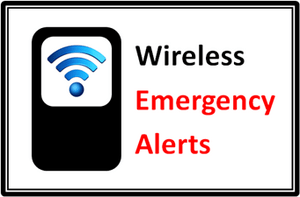Free Wireless Emergency Alerts coming soon; Hurricane season starts Friday

Free Wireless Emergency Alerts (WEA) coming in June 2012.
Activated by local cell tower - a more effective way of getting warnings to those in the storm's path?
Free with all WEA capable devices (WEA "capable" list link below)
Create a More Connected Minnesota
MPR News is your trusted resource for the news you need. With your support, MPR News brings accessible, courageous journalism and authentic conversation to everyone - free of paywalls and barriers. Your gift makes a difference.
2012 Hurricane Season begins Friday, June 1st
"Near Normal" Atlantic Season according to latest NOAA forecast
4 to 8 hurricanes in the Atlantic Basin this year (NOAA forecast)
1 to 3 "Major Hurricanes" according to NOAA
Quick look forecast: Free AC this week!
Source: Twin Cities NWS
WEA: Coming to a cell phone near you
A new (FREE) way to get weather alerts is coming to a phone near you in June.
FEMA/Homeland Security is trotting out "Wireless Emergency Alerts" (WEA) next month. The feature is automated and free, and will relay various weather warnings and local/national emergency alerts and Amber alerts directly to "WEA capable" cell phones.
The wireless industry, The FCC, and FEMA will roll-out the WEA's (Wireless Emergency Alerts) system nationwide this year.
The NWS will start utilizing this by pushing extreme weather warnings over the system in June 2012.
Tornado warnings, flash flood warnings and several other high-end warnings will go direct to wireless users in an affected county automatically if their device is compatible.
The system appears to have one huge advantage over current weather warning apps. The warnings will be delivered to specific locations by cell towers that are localized to the threat area. You'll only get the warning if you're in the affected area. If it works, that's a pretty neat (and effective) feature.
Here are the types of alerts the system will send out.
• Extreme weather warnings
• Local emergencies requiring evacuation or immediate action
• AMBER Alerts
• Presidential Alerts during a national emergency
As for severe weather warnings, here's the list of what NWS will send.
Source: NWS
I'm a little surprised that severe thunderstorms warnings are not on ths list. Perhaps the sheer volume of warnings would overwhelm the system?
You can "opt out" of all of the alerts except the Presidential Emergency Messages.
Here's the link to the list of currently "WEA capable" devices.
Let's see how this rolls out, what advantages and bugs may appear.
Did I mention it's free?
Hurricane Season 2012 opens Friday:
Friday is June 1st (how did that happen?) and the "official" start of the 2012 Atlantic Hurricane Season.
The various forecasts for Atlantic activity are rolling in from NOAA, CSU etc. I'll spare you my usual rant on why I think there is little value in "seasonal" hurricane forecasts. But if you want you can take a look at my reasoning.
NOAA is predicting a "near normal" season in 2012. Here's an excerpt.
2012 Atlantic Hurricane Season Outlook: Summary
NOAA's 2012 Atlantic Hurricane Season Outlook indicates that a near-normal season is most likely. The outlook calls for a 50% chance of a near-normal season, a 25% chance of an above normal season, and a 25% chance of a below-normal season. See NOAA definitions of above-, near-, and below-normal seasons. The Atlantic hurricane region includes the North Atlantic Ocean, the Caribbean Sea, and the Gulf of Mexico.
This outlook reflects the possibility of competing climate factors, combined with several circulation and sea surface temperature (SST) features that suggest a less active season compared to many in recent years. Favoring an above-normal season is the ongoing conditions that have been associated with increased Atlantic hurricane activity since 1995, combined with expected near-average SSTs across much of the tropical Atlantic Ocean and Caribbean Sea (called the Main Development Region, or MDR).
A potentially competing climate factor is the possible development of El Niño during the season. If El Niño develops, it could make conditions less conducive for hurricane formation and intensification during the peak months (August-October) of the season, thus shifting the activity toward the lower end of the predicted range.
If they persist, two other factors that are now present could also compete with conditions associated with the high-activity era. These are: 1) Enhanced vertical wind shear across the MDR, and 2) Cooler-than-average SSTs in the far eastern tropical Atlantic.
Given the current and expected conditions, combined with model forecasts and possible competing factors, we estimate a 70% probability for each of the following ranges of activity during 2012:
9-15 Named Storms,
4-8 Hurricanes
1-3 Major Hurricanes
An Accumulated Cyclone Energy (ACE) range of 65%-140% of the median.
It only takes one major hurricane making landfall in the USA to ruin your day/week/month/year.
To me the real value of hurricane forecasts lie in the short term products put out by NHC. NHC provides tremendous value with track forecasts 3-5 days out. We're still learning about what makes hurricane intensity change so quickly, and skill levels are still evolving on hurricane intensity forecasts.
Our changing climate seems to be redefining all kinds of "seasons" these days. Since we're already into "Beryl" before the "official" start of hurricane season maybe NOAA needs to consider changing the dates for hurricane season to reflect the increased frequency of tropical cyclone outside the June1st-Nov 30th window?
Here's a great animation of Hurricane Andrew as it slammed into Florida and Louisana in 1992. I remember working that Sunday evening at WCCO-TV when Andrew came ashore with devestating effects near Miami.
Hurricane Andrew in 1992
Source: NOAA
Enjoy the free AC and "good sleeping weather this week!
PH